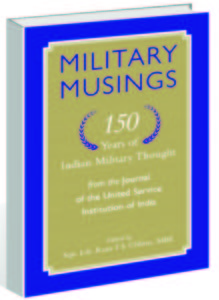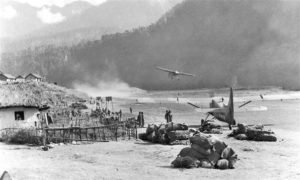
Lt Gen DS Hooda (Retd) Writes :
This book review is from the Online Tribune of 31 March 2021 at:
https://www.tribuneindia.com/news/book-reviews/military-musings-is-about-150-years-of-indian-military-thought-231520
The United Service Institution of India (USI) is a 150-year-old defence services think tank established at Shimla in 1870. The USI Journal has been the ‘flagship’ publication of the institution, reflecting contemporary military and strategic thinking contributed by some of the most respected practitioners and academicians.
The USI has published an anthology of selected articles from the Journal titled ‘Military Musings: 150 Years of Indian Military Thought’. The articles give us a peek into history and military issues that occupied the attention of the British and, post-Independence, the Indian militaries. There are also some personal reminiscences that bring depth to the range of writings.

Army casualties being evacuated from the advanced landing ground at Walong (Arunachal Pradesh) by De Havilland Otters of the IAF, 1962. photo courtesy: USI Journal
Some of the earliest articles are regarding the nature and organisation of the Indian Army and suggestions that the composition be based on “martial races” like the “Puthans, Sikhs, Punjabee Mussulmen, Ghoorkhas, and Rajpoots”. Major Davidson suggests that apart from class regiments, there must be a system of reservists in the native army. A 1908 article discusses the need to inculcate greater responsibility in the ‘Native Officers’ and how British officers’ supervision at almost all events is curbing the initiative of ‘Native Officers’.
As the years passed, the professionalism displayed by the Indian Army in various wars was widely respected. A 1946 ‘letter to the editor’ records an appreciation by a British soldier, “Religious sects and parties may quarrel, but the sepoy has shown that he can sink his differences and fight as an Indian for India.” This spirit remains the most enduring element in the Indian military.
The British strategic focus on the North West Frontier is reflected in the number of articles about this area, including an outstanding paper on the “Strategic Value of Cashmere in Connection with the Defence of our NW Frontier”. For those interested in understanding the strategic geography of the erstwhile state of Jammu and Kashmir, this paper is essential reading.
Two more pieces of interest are a lecture on China and the Chinese army by Lieutenant FE Younghusband and a 1929 article ‘A Re-Definition of Strategy’ by Captain BH Liddell Hart. Liddell Hart later expanded on the concepts explained in the paper in his classic book ‘Strategy’.
The post-Independence writings initially focus on the lessons of World War II. KM Panikkar’s lecture ‘Peace-Making and War-Making in the Twentieth Century’ outlines how warfare has changed from a fight between armies to a fight between nations — a total war.
During this period, there was also a great deal of discussion on customs and traditions in the Indian Army and whether the British legacy needed to be discarded. Major General JD Lunt offers his views, “It may seem strange, or even undesirable, to the younger generation of Indian officers for the Indian Army to perpetuate traditions which in some instances owe their origin to battles fought in India by Indians against Indians, but surely the prime military virtues of loyalty, discipline and courage are what make tradition… These traditions are worth preserving.”
The last few pieces in the anthology reflect India’s current geopolitical challenges. Stephen P Cohen outlines a regional initiative to bring sustained peace to South Asia. Much has changed since Cohen penned the article in 1993, but the need to find solutions to the India-Pakistan tensions remains relevant.
A 2017 talk by the Chinese Ambassador to India discusses various aspects of bilateral relations, touching frankly on the differences and suggesting ways to enhance cooperation. Shivshankar Menon comprehensively outlines security strategies to be adopted by India to emerge as a regional power with global ambitions. As Menon points out, “China’s rise is the foremost challenge which could derail our quest for transforming the lives of Indians.”
‘Military Musings’ is a rich compilation and has a universal appeal. For the historian, its value lies in the historical context in which the articles were penned, rather than the views expressed. For a common reader, it is a glimpse of military thought over the last 150 years through British and Indian writers’ eyes. Pieces like ‘The Riding Ghost of Murree’ and ‘The Old Koi Hai’ provide a flash of nostalgia and humour. The USI and the editor, Sqn Ldr Rana TS Chhina, are to be complimented for their effort.


This Book was compiled as part of the USI of India’s 150th Year celebrations in 2020. The book is being released by the Chief of Defence Staff on 07 April 2021